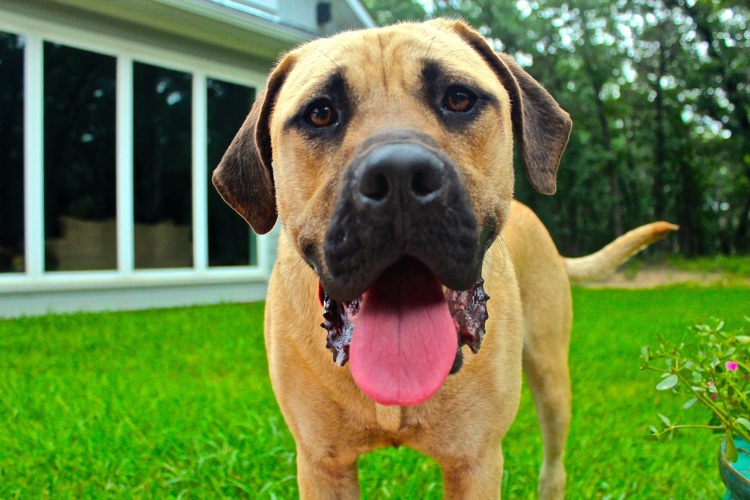Environmental Enrichment Activities for Your Dog
Learn how you can enrich your dog’s surroundings.
As you may have heard, January 21 is National Hug Day. But before you throw your arms around your pooch in celebration of this display of affection, let’s explore this question: Do dogs like to be hugged?
Experts in dog behavior believe that, in general, dogs do not like being embraced. However, every dog has a unique personality. Some may dislike hugs more strongly than others, and some may actually adore them.
The closest thing our furry family members do to a hug is something referred to as ‘standing over’.
As primates, we are wired to express affection through hugging. Even chimps do it! But dogs show their love in other ways, as their legs are not exactly made to wrap around another dog or person. Hugging is truly a foreign concept to our canine companions. When you throw your arms around your pup, they’re probably thinking, why does my human do this? – Much like the way we ask ourselves why dogs sniff each other’s behinds when they meet. Although humans and canines have been intimately connected throughout our evolutionary history, there are still some primal instincts and forms of communication that we do not share—and hugging is one of them.
The closest thing our furry family members do to a hug is something referred to as “standing over,” which is when a dog puts their leg over another dog’s back or shoulder. It is not an aggressive behavior, but thought to show competitiveness or control. It’s common to see dogs do this while they’re roughhousing.
So how can you tell what your dog is feeling when you give them a loving squeeze? The best way is to observe their body language while you’re hugging them. It’s important to note that just as dogs have their own unique personalities, they also have their own individual ways of expressing emotion.
If you have a dog that that’s not too fond of close contact, he probably won’t enjoy being held or squeezed. In this case, it might be best not to attempt a hug, because, just like us, little things can make our pets anxious. It may be a cause for concern, though, if they start exhibiting unwanted or compulsive behaviors—but don’t fret too much if all they do is pull away from your embrace. Since you know your dog’s personality best, you can probably guess what kinds of interactions your dog will tolerate and what will make them uneasy.

A good way to gauge your dog’s reaction to a hug is to have someone take a picture of the two of you. If you don’t have anyone around to snap a photo of you and your pup, try snapping a selfie or looking in the mirror at your dog’s face when you go in for a hug. A dog that is uncomfortable with an embrace may keep their mouth closed and have a tense expression on their face. They might also hold their ears back against their head or try to escape. Unfortunately, what we believe to be a loving cuddle may come across more to them as a move straight out of a professional wrestling match.
A relaxed dog may pant calmly, its mouth and tongue looking rather slack. If your dog is enjoying your hug, they might also lean into you or lick your face.
Here are some doggie behaviors that can show they like your hugs, or that they’re happy in general:
Dogs wag their tails for many different reasons. It can communicate fear, tension, and happiness as well as a whole swell of other emotions. When a dog is really happy, they tend to wag their tail with their entire back end. You probably notice your dog wagging in this way when you greet them at the door.
If your pup is wagging their tail in a loose, relaxed way, it’s a good indicator that they’re calm and enjoying the moment.
Does your dog put their paw over your arm or on your lap when you hug or scratch them? This could be their way of saying, “I like this attention, keep it coming!”
Paws aren’t just for digging holes in the yard; they’re also a major communication tool for dogs. If your pup ever comes up to you while you’re sitting down or distracted by something and gets your attention with their paw, they could be saying they want water, are hungry, or are just looking for some cuddles.
Our furry family members love to learn, especially when a reward is involved, so it’s possible to use positive reinforcement to teach them that hugs are good and not a threat. Teaching a dog to tolerate hugs can be beneficial in situations when you may need to hold them still, like during a visit to the vet or groomer. Also, if you have small children around your home, it can be helpful to get your dog used to having arms around them.
Here’s what you can do to teach your dog that hugs aren’t so bad after all:
Eventually, the cycle of embracing and treat giving should help your dog associate hugs with something positive.
It’s important to remember that some dogs may really like hugs from their human family, but not from new acquaintances. It’s the same way we like close physical contact from friends or family, but we might feel awkward or freaked out if a stranger gets too close to us. Watch out for warning signs that your dog is uneasy around strangers to prevent any mishaps.
Although we humans communicate differently than our canines, we are still very similar in a lot of ways. It’s amazing how close and compatible our two different species have grown to be. Understanding what our dogs are really saying and listening to them can help us grow even closer.
Check out these additional tips for reading your pet’s body language!